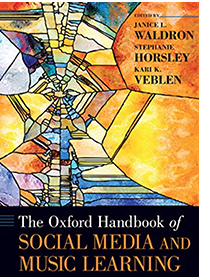The rapid pace of technological change over the last decade has deeply affected the ways in which we interact, says Janice Waldron, associate professor of music education in the School of Creative Arts.
 She explores the ways which social media is now firmly engrained in all aspects of music education in The Oxford Handbook of Social Media and Music Learning, which she edited with Western University colleagues Stephanie Horsley and Kari Veblen.
She explores the ways which social media is now firmly engrained in all aspects of music education in The Oxford Handbook of Social Media and Music Learning, which she edited with Western University colleagues Stephanie Horsley and Kari Veblen.
Chapters in the book draw attention to the ways in which social media, musical participation, and formal, informal, and non-formal musical learning are increasingly entwined in a networked society. The handbook contains 32 chapters with more than 50 authors contributing.
“I look at how people use a platform to learn music,” says Dr. Waldron. “It is not a substitute for face-to-face learning, as we all know, but it’s one of those things people use when you can’t do face-to-face learning. Find an online community and it’s the next best thing.”
Waldron contacted Drs. Horsley and Veblen about her idea for the handbook in 2015. They completed the submission process to Oxford University Press and received a contract for the handbook in June 2016. She notes that Oxford handbooks are prized as publications because they are so broadly read and referenced.
Waldron herself plays whistle, Irish pipes, and flute. A member of the Irish music discussion board Chiff and Fipple since 2000, she hadn’t thought of that activity as a way people were learning music.
“People on these discussion boards would upload YouTube videos of famous musicians or themselves and ask for feedback,” says Waldron. “In 2020, we look at this and say, of course you do that. But in 2007, it wasn’t something music education researchers or practitioners were aware of. I really was the only person in music education who was talking about learning online in online music communities of practice.”
Now she is applying some of these technologies in a course she teaches on conducting.
“We aren’t going to be able to use livestream conducting this fall because of the lag between audio and visual,” Waldron says. “We’ll be using private YouTube channels. Each student will create their own private channel to post and submit their conducting exercises.”
—Susan McKee
